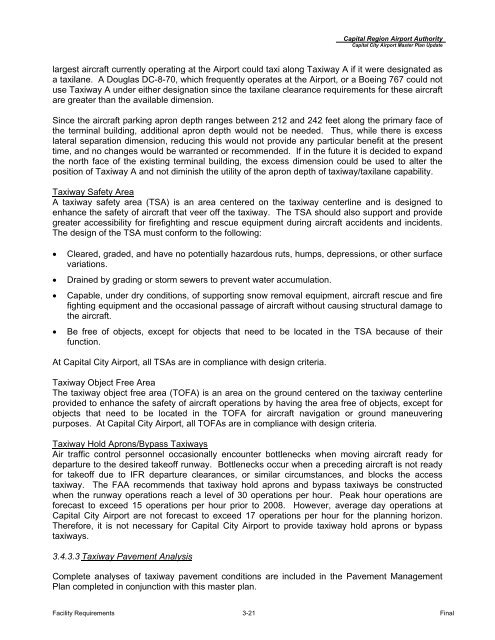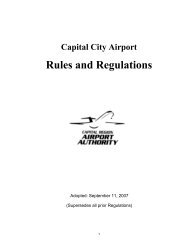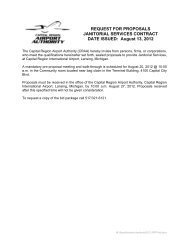Master Plan Update (pdf) - Lansing/Capital City Airport
Master Plan Update (pdf) - Lansing/Capital City Airport
Master Plan Update (pdf) - Lansing/Capital City Airport
You also want an ePaper? Increase the reach of your titles
YUMPU automatically turns print PDFs into web optimized ePapers that Google loves.
<strong>Capital</strong> Region <strong>Airport</strong> Authority<br />
<strong>Capital</strong> <strong>City</strong> <strong>Airport</strong> <strong>Master</strong> <strong>Plan</strong> <strong>Update</strong><br />
largest aircraft currently operating at the <strong>Airport</strong> could taxi along Taxiway A if it were designated as<br />
a taxilane. A Douglas DC-8-70, which frequently operates at the <strong>Airport</strong>, or a Boeing 767 could not<br />
use Taxiway A under either designation since the taxilane clearance requirements for these aircraft<br />
are greater than the available dimension.<br />
Since the aircraft parking apron depth ranges between 212 and 242 feet along the primary face of<br />
the terminal building, additional apron depth would not be needed. Thus, while there is excess<br />
lateral separation dimension, reducing this would not provide any particular benefit at the present<br />
time, and no changes would be warranted or recommended. If in the future it is decided to expand<br />
the north face of the existing terminal building, the excess dimension could be used to alter the<br />
position of Taxiway A and not diminish the utility of the apron depth of taxiway/taxilane capability.<br />
Taxiway Safety Area<br />
A taxiway safety area (TSA) is an area centered on the taxiway centerline and is designed to<br />
enhance the safety of aircraft that veer off the taxiway. The TSA should also support and provide<br />
greater accessibility for firefighting and rescue equipment during aircraft accidents and incidents.<br />
The design of the TSA must conform to the following:<br />
• Cleared, graded, and have no potentially hazardous ruts, humps, depressions, or other surface<br />
variations.<br />
• Drained by grading or storm sewers to prevent water accumulation.<br />
• Capable, under dry conditions, of supporting snow removal equipment, aircraft rescue and fire<br />
fighting equipment and the occasional passage of aircraft without causing structural damage to<br />
the aircraft.<br />
• Be free of objects, except for objects that need to be located in the TSA because of their<br />
function.<br />
At <strong>Capital</strong> <strong>City</strong> <strong>Airport</strong>, all TSAs are in compliance with design criteria.<br />
Taxiway Object Free Area<br />
The taxiway object free area (TOFA) is an area on the ground centered on the taxiway centerline<br />
provided to enhance the safety of aircraft operations by having the area free of objects, except for<br />
objects that need to be located in the TOFA for aircraft navigation or ground maneuvering<br />
purposes. At <strong>Capital</strong> <strong>City</strong> <strong>Airport</strong>, all TOFAs are in compliance with design criteria.<br />
Taxiway Hold Aprons/Bypass Taxiways<br />
Air traffic control personnel occasionally encounter bottlenecks when moving aircraft ready for<br />
departure to the desired takeoff runway. Bottlenecks occur when a preceding aircraft is not ready<br />
for takeoff due to IFR departure clearances, or similar circumstances, and blocks the access<br />
taxiway. The FAA recommends that taxiway hold aprons and bypass taxiways be constructed<br />
when the runway operations reach a level of 30 operations per hour. Peak hour operations are<br />
forecast to exceed 15 operations per hour prior to 2008. However, average day operations at<br />
<strong>Capital</strong> <strong>City</strong> <strong>Airport</strong> are not forecast to exceed 17 operations per hour for the planning horizon.<br />
Therefore, it is not necessary for <strong>Capital</strong> <strong>City</strong> <strong>Airport</strong> to provide taxiway hold aprons or bypass<br />
taxiways.<br />
3.4.3.3 Taxiway Pavement Analysis<br />
Complete analyses of taxiway pavement conditions are included in the Pavement Management<br />
<strong>Plan</strong> completed in conjunction with this master plan.<br />
Facility Requirements 3-21 Final




